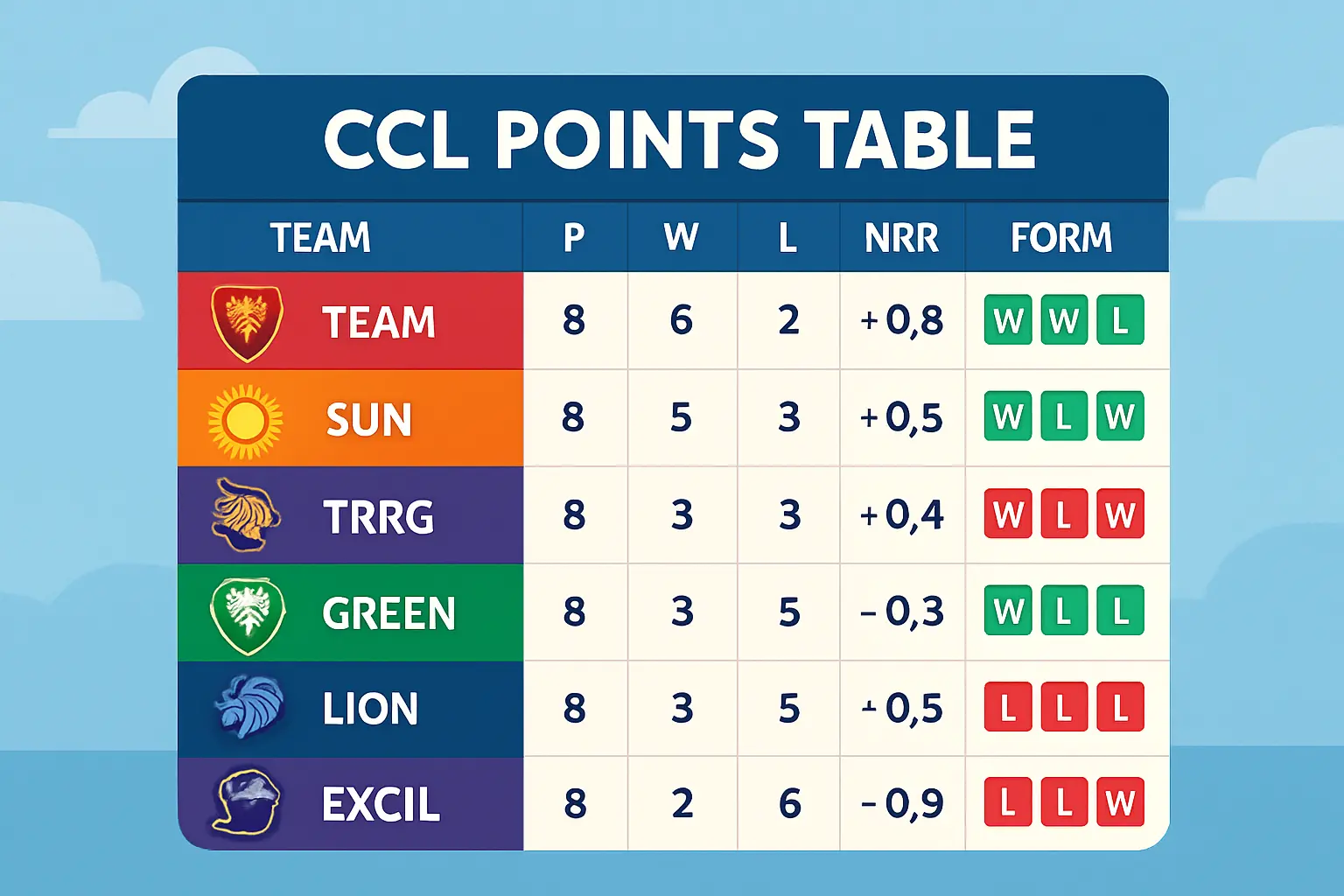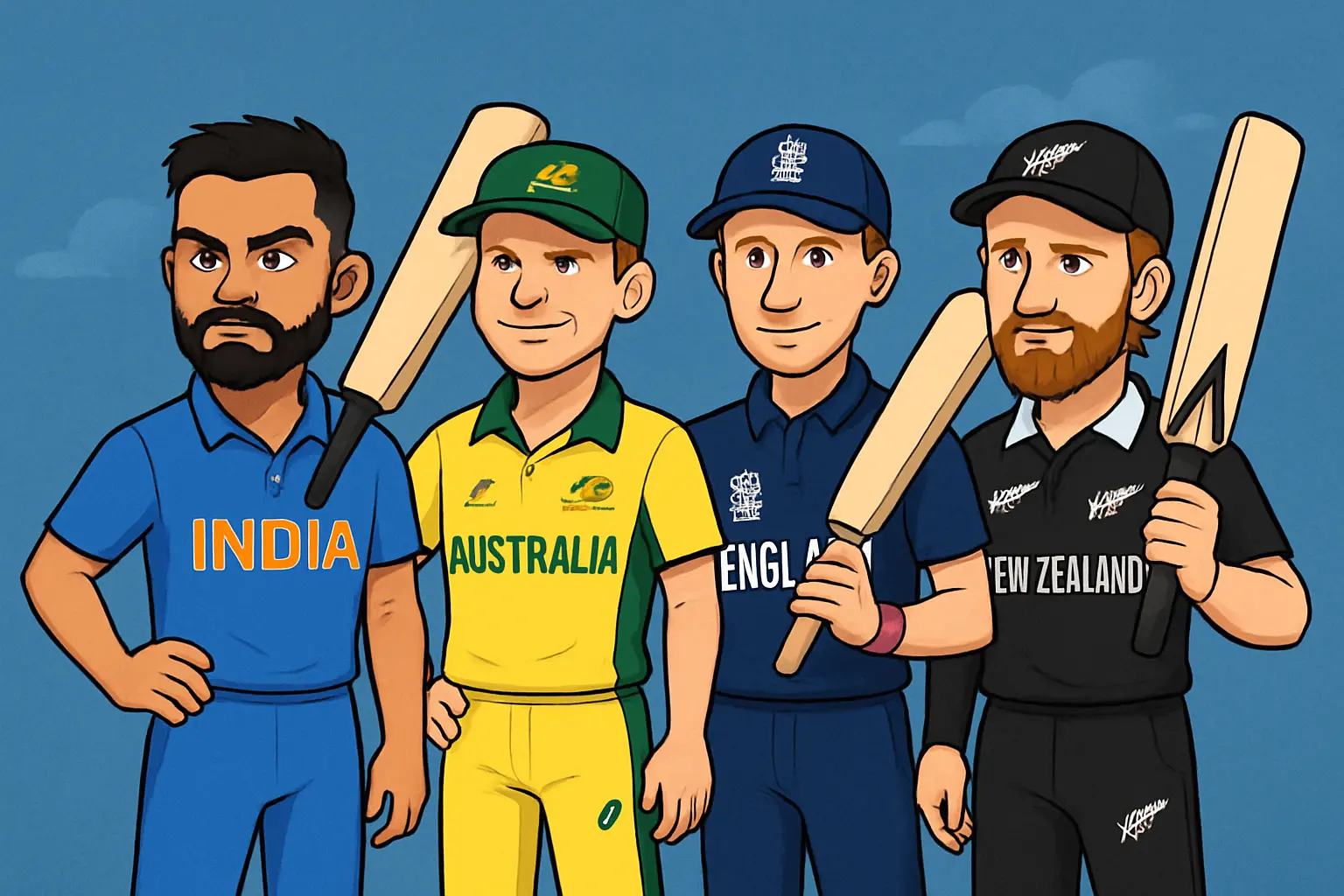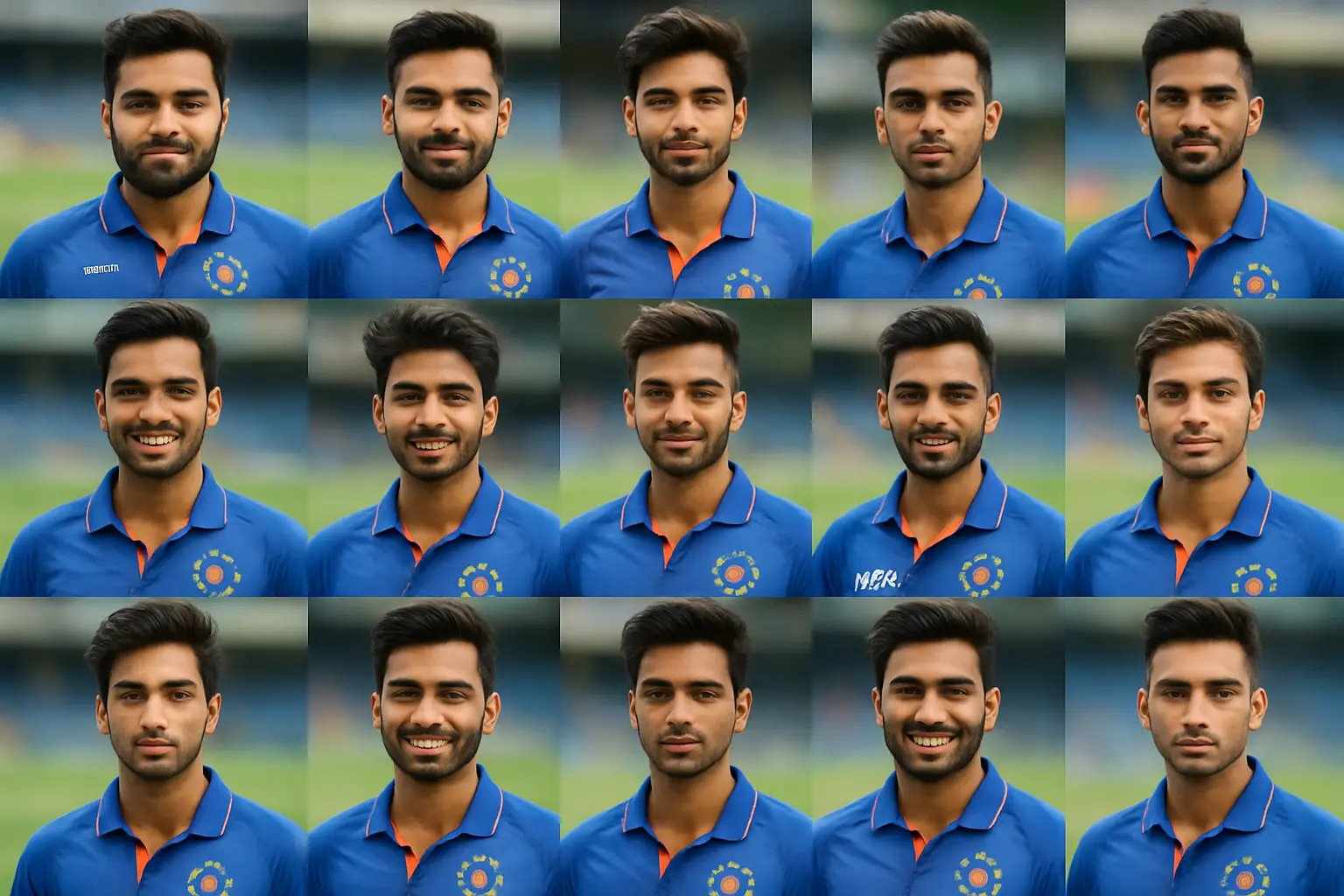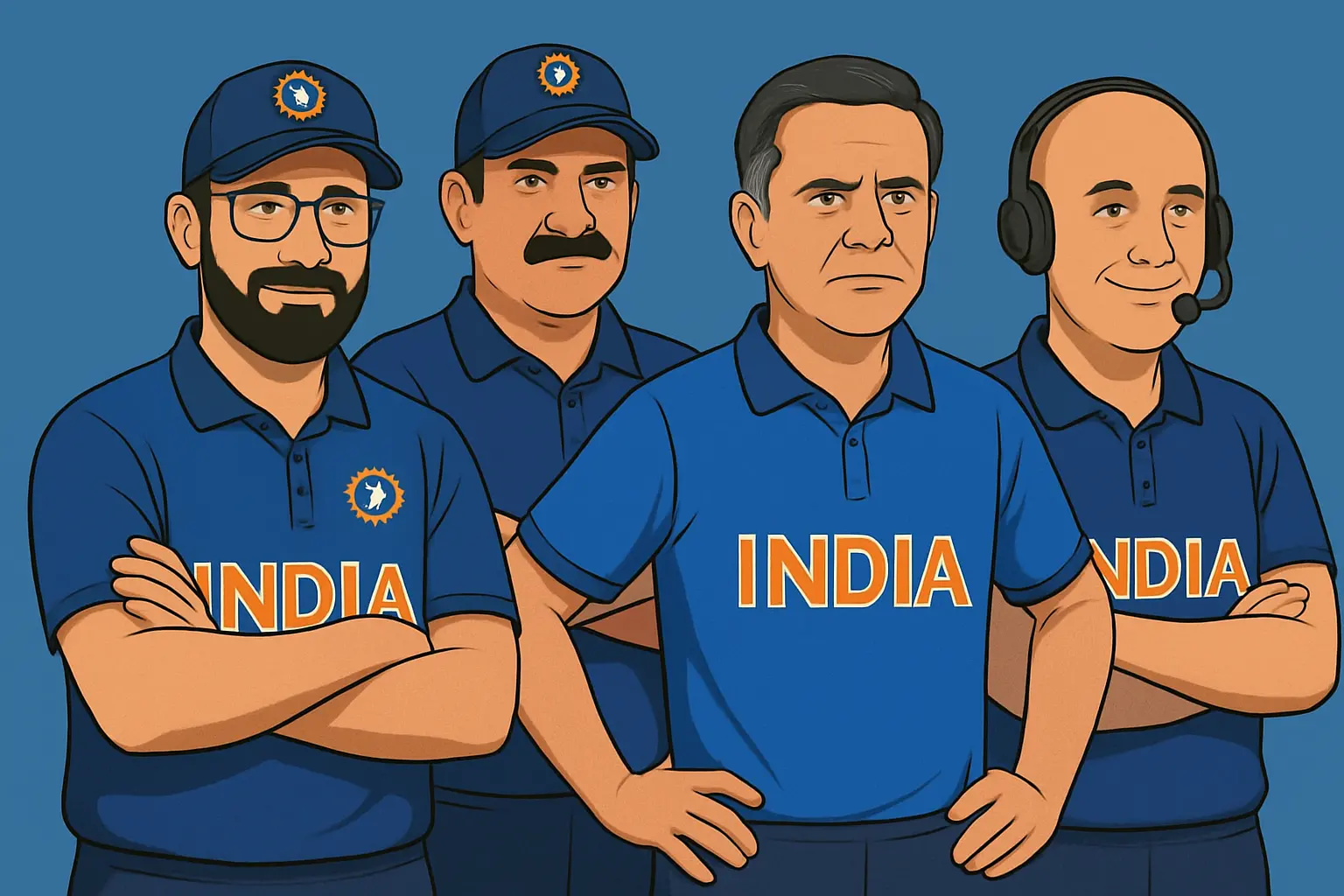The all-rounder is ODI cricket’s great shape-shifter. One day he wrestles a game with new-ball movement and dots; two days later he drags a chase from rubble with clean wrists and late cuts. The best ODI all-rounders are not just the glue between batters and bowlers. They are accelerators and shock absorbers, pressers of advantage and breakers of deadlock. They make captains greedy, because every over they deliver or every boundary they find rebalances a one‑day match in your favor.
If you’ve argued in a press box or a clubhouse about who sits at the top, you know the problem: raw career numbers, more often than not, lie about true value. Early-ODI strike rates look quaint today. Death overs are a different planet from powerplay overs. Fielding used to be a bonus; it’s now a weapon. To cut through the noise, this piece ranks the greatest ODI all‑rounders of all time and the top ranked ODI all-rounders right now with one clear principle: context first, then volume.
The All‑Rounder Index: our transparent, era‑adjusted model
This ranking is powered by a single career metric we call the All‑Rounder Index (ARI). Every player gets a score out of 100, drawn from five pillars. The aim is simple: credit runs and wickets relative to the era and match situation; reward those who bend results, not just scorecards.
All‑Rounder Index (ARI) breakdown:
- Batting Value (35 points)
- Batting Avg+ and SR+ versus era (weighted by position)
- Finishing Impact: weighted runs in overs 35–50 and in chases, with bonus for not-outs when required rate was steep
- Opponent/venue adjustment: away and neutral matches weighted higher than home
- Bowling Value (35 points)
- Bowling Avg+ and Econ+ versus era (quality of wickets and dot-ball pressure)
- Phase Impact: powerplay control vs middle-overs strangulation vs death overs survival
- Wickets Above Replacement: wickets taken beyond what a typical fifth bowler would manage in similar conditions
- Match Impact (10 points)
- Player‑of‑the‑Match rate, Win Probability Added, knockout/game-deciding contributions
- Fielding (10 points)
- Catch rate, direct hit/run-out involvement, positional difficulty, boundary-saving metrics where available
- Longevity and Adaptability (10 points)
- Years of relevance, multi-condition competence, performance with captaincy and under fatigue
For readers who chase method over mystique: we do not punish a batting all-rounder for having a lighter bowling load, nor the reverse. Role weightings are applied to prevent “bits-and-pieces” accumulation; you must drive at least one discipline and support the other to score elite ARI.
How this beats the obvious lists
- We adjust for eras. A batter striking at 80 in a low‑par scoring period might be more valuable than a modern 95 who starts slowly and relies on batting depth.
- We read the phases. A bowler who concedes a run a ball at the death can be more valuable than a miserly middle‑overs tweaker if the team’s composition demands it.
- We count the quiet wins. A seven‑over spell that ends a chase with control at 4.2 per over, or a 41* off 36 with a tail in a slow chase, weighs heavy here.
The greatest ODI all-rounders of all time: a ranked, data‑led list
Below is our ARI top tier — a living list refined with new data and historical tape. ICC lists give you who’s hot; this gives you who’s truly great.
Top all‑time ODI all-rounders (ARI ranking)
| Player | Primary role | Team | ARI | Snapshot |
|---|---|---|---|---|
| Jacques Kallis | Batting all-rounder | South Africa | 96 | Lidless consistency; 11k+ runs, 250+ wickets; anchor and breaker across conditions |
| Shakib Al Hasan | Spin‑bowling all-rounder | Bangladesh | 95 | Full‑spectrum contributor; elite at 4/5 and ODI‑grade left‑arm spin, outstanding in global tournaments |
| Sanath Jayasuriya | Batting all-rounder | Sri Lanka | 93 | Powerplay revolutionary; 13k+ runs, 320+ wickets; set tempo with the bat, then strangled with spin |
| Imran Khan | Pace‑bowling all-rounder | Pakistan | 92 | Winning captain; hard lengths, reverse swing, and a middle‑order bat who finished games |
| Kapil Dev | Pace‑bowling all-rounder | India | 91 | Smiling assassin; 250+ wickets, dynamic lower‑middle hitting; momentum maker in big games |
| Shaun Pollock | Pace‑bowling all-rounder | South Africa | 90 | Economy king; new-ball menace, rock‑solid at 7; match control specialist |
| Lance Klusener | Batting all-rounder | South Africa | 88 | Death overs demigod; strike rate monster; seamers couldn’t hold their nerve against him |
| Andrew Flintoff | Pace‑bowling all-rounder | England | 87 | Heavy-ball enforcer; hard-to-score spells, and bruising late‑order runs |
| Chris Cairns | Batting all-rounder | New Zealand | 86 | Cleanest arc in the format, hit long without slogging; picked key wickets as first change |
| Shahid Afridi | Batting all-rounder | Pakistan | 85 | Volatility incarnate; match-winning leg‑spin and momentum swings with the bat |
| Richard Hadlee | Pace‑bowling all-rounder | New Zealand | 84 | ODI bowling clinic; lower‑order muscle, but primarily a control‑and‑strike legend |
| Yuvraj Singh | Batting all-rounder | India | 84 | Knockout magnet; left‑arm spin utility and middle‑order matchwinner in chases |
| Ben Stokes | Batting all-rounder | England | 83 | Big‑game temperament; clutch chaser; bowling load situational but match impact towering |
| Ravindra Jadeja | Spin‑bowling all-rounder | India | 83 | Fielding + bowling suffocation; efficient finisher; error-free minutes win ODIs |
| Ian Botham | Pace‑bowling all-rounder | England | 81 | Early‑era trailblazer; ODI bowling impact massive, batting streaks decisive |
Why each choice stands where it stands
Jacques Kallis
There is a right answer to “most valuable ODI all‑rounder over a long horizon,” and it’s Kallis. He is a blunt reply to fashionable lists that reward sizzle over steak. His batting Avg+/SR+ combination, when adjusted for a lower‑par era, is elite even without the fireworks others preferred. Slot him at three or four and he turned matches by deleting collapses, then added seam overs that were more than partnership‑breakers; they changed how captains used the other quicks. His Win Probability Added spikes late in chases and in away tours. Criticism about tempo ignores context: when South Africa needed run rates lifted, he did it; when they needed a platform, he sat in. He is our all‑time ARI leader.
Shakib Al Hasan
If you ask bowlers which batting all‑rounder they hate bowling to and batters which spinner they hate picking, you’ll hear Shakib’s name again and again. He scores in all three gears: early board presence at four, tempo maintenance through singles without risk, and finishing through placement more than six‑hitting. With the ball, he is the perfect ODI metronome: the angle across right-handers, the arm ball at off‑stump, the dip to lefties. He’s relentlessly above replacement in both disciplines. In global tournaments, he’s authored full campaigns where his ARI spikes to near‑Kallis levels. There are seasons where he has been the number 1 ODI all‑rounder by almost any metric.
Sanath Jayasuriya
ODI cricket broke open when Jayasuriya started aiming at the stands inside the first powerplay, but the secret reason he ranks this high is the bowling. His left‑arm spin forced batters to play across the line in the middle overs and made Sri Lanka’s fifth‑bowler problem vanish. The batting SR+ is off the charts relative to his era, and he still mounted an all-time runs tally. He also remains one of the format’s most valuable two‑role players in multi‑nation tournaments, where he delivered with both bat and ball.
Imran Khan
You could build an entire ODI bowling plan around Imran’s control of lengths and reverse swing. He would open and return at the death, and the quality of wickets taken is ridiculously high. Add in batting at five or six with a temperament for chasing under lights, plus captaincy that lifted everyone around him, and his match impact outruns his counting stats. ARI features a spike in high‑leverage overs — Imran owns one of the larger spikes we measured.
Kapil Dev
Kapil brought showmanship and ruthlessness to ODIs. He could wobble the seam at brisk pace across the top and then thrash in the closing overs. He was not a “bits and pieces” cricketer; he was a run rate distorter. ODI folklore preserves the famous counterpunching hundred against Zimbabwe, but a lot of Kapil’s value came in eight‑over spells where he removed an opener and conceded nothing thereafter. He translates beautifully to modern analytics: Econ+ elite, wicket quality strong, and Finishing Impact higher than many remember.
Shaun Pollock
No bowler on this list had a lower stress profile over the long run. Pollock’s spells let captains plan. It’s rare for a strike bowler to also be an economy bulwark; Pollock was both. The bat gave him flexibility at seven or eight, often finishing low‑par chases or bolting on 30 off 25 to shift a par score twenty runs forward. If your team already has hitters, Pollock’s ARI is almost the perfect additive value.
Lance Klusener
A generation of middle‑over seamers developed a twitch because of Klusener. He went around the wicket and hit flat lines into the arc between long‑on and midwicket. Bowl too wide, and he fetched you over point. A reductive reading would say he’s a batting all‑rounder who bowled a bit; our model rates his death‑over bowling bursts, especially on decks with tennis-ball bounce, as clutch. His Player‑of‑the‑Match rate in multi‑team tournaments rivaled the greatest.
Andrew Flintoff
The ODI Flintoff delivered heavy‑ball hostility: short of a length that climbed, forcing miscues into the ring. Over the years he tightened his batting to be a trusted five or six. His ARI benefits from Wickets Above Replacement because England often needed him to play first‑change strike bowler and bank ten overs. For a time, he was England’s ODI heartbeat, and that matters in pressure environments where WPA swells.
Chris Cairns
Cairns belonged to the rare club who could set fields with the bat. Oppositions moved their mid‑ons back before he arrived; that already gave him singles. He bowled a mix of seamers that won New Zealand big matches. His career was streaky due to injuries, but in his long peaks the balance of his contributions is textbook “ODI all‑round.”
Shahid Afridi
You don’t get Afridi without chaos. The faster leg‑breaks, the wrong’un flat on off stump, the ability to sprint through overs and put a chase off the clock — all that is part of Afridi’s bowling value. With the bat, yes, there were droughts. But when Afridi teed off from seven, the worm graph went ballistic. He is penalized by low consistency but rescued by ties to match breakthroughs. No bowler frightened set batters with flat spin more regularly, and that matters in ODIs.
Richard Hadlee
ODI Hadlee was a craftsman. While not a heavy ODI bat, his bowling ARI is elite due to Avg+, Econ+, and the quality of wickets. In chase control scenarios — defending low scores on two-paced decks — nobody was richer. If your squad has an established top six, Hadlee’s profile spikes further, because you don’t need his batting as often.
Yuvraj Singh
ODI Yuvraj lives for knockout days and thick air. A left‑arm spin spell of six overs for 20 may not read like a game‑changer, but in a side with attacking quicks it freed them to hunt at the other end. The batting is what shoots him up: he could build a chase at 4‑ish an over and still finish with a gear shift. ODI cricket never found a better through‑the-line striker at cover when set.
Ben Stokes
Bowling availability varies, so his role is more decisively batting all‑rounder, but that bat is as clutch as this format has seen. He plays the rehearsal shots early and holds nerve late. The model rewards him for high‑leverage wins and the ability to soak pressure with fielders up. Even when he doesn’t bowl ten, his overs tend to arrive where the game lives: on turning points.
Ravindra Jadeja
Legendary fielding, laser run‑outs, boundary saves that rip ten runs off a scorecard without anyone noticing — Jadeja’s fielding component is among the highest in the data set. Add suffocation spin in middle overs and a finisher’s average with more control than slog, and his ARI hums. He turns par 290s into 270s from the field alone.
Ian Botham
ODI Botham, before the white-ball skill tree exploded, taught teams that a strong seamer at the top who could also hoist down the order bent the entire shape of a day. The batting SR isn’t modern, but the timing of his runs and the scale of his wickets places him as an era anchor.
Kallis vs Shakib: the ultimate ODI all‑rounder debate
- Peak vs longevity: Shakib at peak in multi‑nation tournaments may have the highest single‑season ARI of anyone. Kallis across long windows wins the marathon.
- Role difficulty: Kallis batted higher and often against the new ball in seaming conditions. Shakib provided bowling control every day. The model weights those differences; the net result is a razor-thin spread.
- Knockout and away weighting: Shakib’s set of big‑stage knocks plus his 10‑overs-every-day reliability tightens the gap to near parity.
The best current ODI all-rounders right now
ICC ODI all‑rounder rankings shine a light on form and recency. Our “current” cut layers that with role value and matchup versatility. These are the names you trust to win a one‑day game this minute, not a career ago.
Current ODI all-rounders (editorial tier, model‑informed)
- Shakib Al Hasan — The control tower. Still builds totals in the middle overs and does not let batters breathe when he bowls. In series where he bats top five, his Finishing Impact remains world-class.
- Sikandar Raza — Zimbabwe’s heartbeat. Batting SR and boundary percentage in the middle overs are elite, and he bowls the hard overs against left‑handers without complaint. MOTM rate off the charts.
- Ravindra Jadeja — If your team is pocked with hitters, Jadeja is priceless as the field general and pressure spinner who also hits straight at the death.
- Glenn Maxwell — The unicorn. Powerplay overs to right-handers, off-spin with deception, and a finisher who can also rescue at 40 for four. WPA surges when he is at the crease during chases.
- Mehidy Hasan Miraz — Grown from promising offie into a genuine top‑order option, a rarity for a bowling all‑rounder. Adds flexibility to Bangladesh’s balance without sacrificing control.
- Hardik Pandya — Not always a ten‑over workload, but the overs he bowls change death dynamics. With the bat, he is among the best finishing all‑rounders in ODI cricket.
- Mitchell Santner — Left‑arm spin mastery in white ball, sharp fielding at point/cover, left‑handed lower‑middle finishing with smart risk mapping.
- Wanindu Hasaranga — The attacking leggie ODI teams plan around, with a bat that keeps totals afloat. Match-up bowling and wicket-taking intent raise his ARI despite occasional runs leaked.
- Mohammad Nabi — Endless experience, calm in chases, and one of the most efficient white‑ball off-spinners of his era. He has been a floor‑raiser for Afghanistan.
- Sean Williams — High‑IQ left‑hand batter with the patience to bat through and the spin to keep things at a run a ball or below in the middle.
Who is number 1 among the current ODI all‑rounders? Our live model typically alternates between Shakib, Jadeja, and Raza depending on fitness and opposition. If you want a single name without asterisks: a fit, fully engaged Shakib still grades the highest because he ticks all three day‑to‑day boxes — batting solidity, bowling control, and fielding certainty — in every series.
Role‑specific excellence: when “all‑rounder” means different jobs
Best batting all‑rounders in ODIs
- Jacques Kallis — Anchor‑plus; the rare player who raises your par score without appearing to take risks.
- Sanath Jayasuriya — Opened with intent and defined powerplay freedom; his bowling seals his place as truly “all‑round.”
- Yuvraj Singh — Middle‑order sculptor; used angles, late cuts, and pick‑ups; with spin overs that saved the quicks.
- Ben Stokes — Modern chasing maestro, elite temperament; overs come when required.
- Glenn Maxwell — A finisher’s finisher, range‑hitting and reverse sweeps make fields impossible to set.
Best bowling all‑rounders in ODIs
- Imran Khan — Wickets above replacement immense; batting decisive in the higher middle order.
- Shaun Pollock — Economy artisan; 7 or 8 with the bat gave balance.
- Ravindra Jadeja — A ten‑over banker whose bat and fielding add at least twenty invisible runs.
- Richard Hadlee — Match control across conditions; lower‑order muscle late.
- Shakib Al Hasan — A metronomic left‑arm spinner who bats in the engine room.
Finishing all‑rounders in ODIs
- Lance Klusener — Death overs legend.
- Hardik Pandya — Modern template: fast hands, clean down the ground, no panic.
- Glenn Maxwell — Offers both the bailout and the encore.
- Chris Cairns — Turned par into plus‑twenty outcomes late.
- Shahid Afridi — The chaos option; when it works, totals swing fifty runs.
Power‑hitting all‑rounders in ODIs
- Jayasuriya, Afridi, Klusener, Maxwell, Cairns — a line of players who force captains to keep long‑on and long‑off back, even in the forties.
Pace‑bowling all‑rounders in ODIs
- Imran, Kapil, Pollock, Flintoff, Botham — command of new ball and death navigation; with bats that aren’t optional.
Spin‑bowling all‑rounders in ODIs
- Shakib, Jadeja, Jayasuriya, Nabi, Santner — match‑up assassins who take pace off and take time away.
Country and regional snapshots: the best ODI all-rounders by nation
Best Indian ODI all‑rounders
- Kapil Dev — The template. Won matches with late hitting and seam.
- Yuvraj Singh — Knockout giant; spin utility crucial to balance.
- Ravindra Jadeja — Fielding phenomenon; controls middle overs; finishes with maturity.
- Hardik Pandya — Modern finisher; bowling adds selection freedom.
- Sachin Tendulkar as utility — Not a classical all‑rounder, but hundreds of overs of problem‑solving seamers and leg cutters won games.
Best Pakistan ODI all‑rounders
- Imran Khan — Greatest leadership and ODI bowling influence in Pakistan’s story.
- Shahid Afridi — Wicket‑taking leg‑spin, adrenaline batting.
- Wasim Akram (utility) — Primarily a bowler, but useful lower‑order hitting and smart batting conversions.
- Abdul Razzaq — Long-arc finisher, heavy down the ground hitting and reliable medium pace overs.
- Mohammad Hafeez — Off‑spin matchups and top‑order elegance; perfect ODI balance piece.
Best Bangladesh ODI all‑rounders
- Shakib Al Hasan — The nation’s North Star in ODIs.
- Mehidy Hasan Miraz — The rise that solved balance without sacrificing bowling.
- Mahmudullah — Rarely classified as all‑rounder now, but medium pace and finisher’s batting created balance in key cycles.
- Nasir Hossain (utility) — Periods where he provided top‑six batting with overs of control.
Best Sri Lankan ODI all‑rounders
- Sanath Jayasuriya — The engine of an entire ODI revolution.
- Angelo Mathews — Finisher‑captain profile with seam overs in his prime.
- Farveez Maharoof (utility) — Underrated ODI skill set with bat and ball in swing‑friendly venues.
- Thisara Perera — Inconsistent, but impact innings and change‑ups with the ball.
Best Australian ODI all‑rounders
- Shane Watson — Opening bat matched with skiddy seam; period of dominance as top‑order all‑rounder.
- Andrew Symonds — Boundary rider par excellence; off‑spin and medium pace; batting that broke chases.
- Glenn Maxwell — Redrew white‑ball geometry with bat and off‑spin matchups.
- Steve Waugh (utility) — Middle‑order backbone, overs of cutters on slow tracks.
- Cameron Green — Project player with ceiling to join the pantheon if bowling load stabilizes.
Best South African ODI all‑rounders
- Jacques Kallis — The atlas on which South African ODI batting sat.
- Shaun Pollock — Precision, control, and depth in batting.
- Lance Klusener — Death overs sledgehammer.
- Chris Morris (utility) — Strike bowling and late‑order power packages in bursts.
- Andile Phehlukwayo — Finishing bat, cutters and back‑of‑the‑hand deliveries in the middle overs.
Best England ODI all‑rounders
- Andrew Flintoff — The heartbeat and heavy-ball enforcer.
- Ben Stokes — Big‑game DNA; batting all‑rounder who bowls shock overs.
- Moeen Ali — Off‑spin flexibility and floaty ease with the bat; role glue.
- Sam Curran (utility) — Left‑arm angle and swing with late hitting, still forming the full ODI package.
- Ian Botham — Early ODI power; a foundational figure.
Best New Zealand ODI all‑rounders
- Chris Cairns — Complete white‑ball all‑rounder at his best.
- Richard Hadlee — ODI bowling poet.
- Mitchell Santner — A modern model of control and catching range.
- Corey Anderson — Brief peak, huge middle-overs six-hitting, medium pace overs in seam-friendly conditions.
- Scott Styris — Middle‑order batting with clever seamers, especially on slow pitches.
Best Afghanistan ODI all‑rounders
- Mohammad Nabi — Calm and calculating, off‑spin chess player with a bat that adapts.
- Rashid Khan (utility) — Primarily a bowler, but his batting stings enough to matter in ODI totals.
- Gulbadin Naib — Medium pace overs, flexible batting; profile value varies with role clarity.
Best Zimbabwe ODI all‑rounders
- Sikandar Raza — The definition of modern Zimbabwean ODI resilience: runs under pressure and wickets with off‑spin.
- Sean Williams — Reliable bat and spin, the metronome that steadies campaigns.
- Heath Streak (utility) — Primarily a bowler, but valuable late-order runs in low totals.
Event lens: the best all-rounders in ODI World Cup history
Big tournaments punish passengers. The best ODI all-rounders in World Cup history carry ARI spikes because they do two jobs when teams cut benches and lengthen their top six.
- Sanath Jayasuriya: tournament‑defining powerplay batting plus wickets, particularly on slow Asia surfaces.
- Kapil Dev: that counterpunching masterclass and consistent wicket-taking through new and old balls.
- Imran Khan: captaincy gravity and death overs composure, plus batting at five/six.
- Yuvraj Singh: Player‑of‑the‑Tournament‑level dominance with both disciplines; cancer‑era heroism welded to hard numbers: wickets when the ball turned and runs in control chases.
- Shakib Al Hasan: one of the most complete all‑round tournament campaigns recorded; batting volume and bowling control in the same fortnight.
- Ben Stokes: tide‑turning innings in pressure; overs squeezed after field restrictions that freed the attack.
How to read the stats that truly matter
- 5000 runs and 200 wickets in ODIs: Kallis, Jayasuriya, Afridi, Shakib — these are rare birds, because maintaining run volume while bowling enough to take 200 requires iron fitness and team trust.
- 2000 runs and 100 wickets: a broader club featuring names like Kapil, Pollock, Imran, Yuvraj, and Jadeja over time — still elite because 100 ODI wickets is not trivial for a part‑timer.
- Most man‑of‑the‑match awards among all‑rounders: Afridi’s spikes, Jayasuriya’s long dominance, and Shakib’s balanced campaigns loom large.
- Best ODI all‑rounder strike rate/economy ratio: look to Jayasuriya and Klusener for SR brilliance; Pollock and Hadlee for Econ+ mastery. ARI converts these into era-relative values.
Tactical anatomy: what makes a good all‑rounder in ODIs
- Phase fit: Can you bat where the innings needs it? Open with intent, build in the middle, and finish late — very few can do all three. Klusener could finish. Kallis could build. Maxwell can rescue and finish.
- Two distinct threats: Your secondary discipline cannot be token overs. Jadeja’s ten overs and Shakib’s daily spell shape matches. Imran’s spell packages cost teams wickets and surrendered no freebies.
- Fielding: If you can save ten runs a game in the ring, you’re adding twenty invisible ARI points over a series. Jadeja made this into an art form.
- Role stability: The best all-rounders know their weekly job. In selection rooms, players who anchor a plan are gold.
- Durability and adaptability: ODI cricket asks for travel, changing white balls, heat rolls, and dew tricks. Greats produce after a night of travel and on a dry road two days later.
A closer look at era context: why SR+ and Econ+ matter
- Batting SR+: A modern 90 can be inferior to an earlier 80 if the earlier number was achieved with wickets in hand and against true movement. Jayasuriya’s SR+ is era-insane; Kallis’s SR+ looks pedestrian raw, but improved dramatically against same‑era comparables, especially with match situation accounted for.
- Bowling Econ+: Economy is not all illusions; it’s usage. Pollock at 4.0 in an environment where par was 5.0 is better than a modern 5.0 when par is 5.3, particularly if the overs came at the start and end rather than only in the middle.
- Death vs middle: Bowlers who survive at the death with a run a ball and strike once are worth double a comfortable middle‑overs tidy worker when match situation calls for it. Klusener’s death mastery and Imran’s late overs shine here.
Comparison mini‑profiles: head‑to‑head snapshots
Kallis vs Jayasuriya
- Archetype: anchor‑breaker vs tempo‑setter
- Batting value: Kallis creates par security; Jayasuriya inflates par. On flat decks, Jayasuriya wins; in bowler‑friendly venues, Kallis’s wicket conservation wins often.
- Bowling value: Jayasuriya’s middle overs matured into a proper second spinner; Kallis’s seamers were more situation‑targeted. The net is a near‑draw.
Shakib vs Jadeja
- Both are left‑arm spinners who bat in the middle. Shakib’s batting ceiling and primary batting position raise his ARI; Jadeja’s fielding gives him the best defensive impact per minute in ODI cricket.
- When a team lacks finishing, Shakib is the pick; when a side needs ten overs of certainty plus elite ring defense, Jadeja becomes number 1.
Klusener vs Hardik
- Power at the death with seam bowling vs power at the death with pace‑off bowling and cutters. Klusener’s pure hitting might be more ferocious; Hardik’s bowling, when fit, arrives at the exact overs where good teams demand balance.
Best ODI all‑rounders for fantasy cricket and captaincy picks
- High floor picks: Shakib, Jadeja, Pollock (historical lens), Santner — they give you wickets or economy, plus a baseline of runs and catches.
- Ceiling picks: Maxwell, Afridi, Klusener — the day they fire, your points graph is a staircase.
- Safe captaincy in balanced conditions: Kallis in the all‑time game; Shakib in modern pools.
- Conditions leans: On slow decks, bank spin‑bowling all‑rounders. On green seams, pace‑bowling all‑rounders rise; Flintoff‑type profiles gather wickets in two spells.
How ODI strategy made the all‑rounder indispensable
ODI teams evolved from five bowlers and six batters to four front‑line bowlers, one all‑rounder, a couple of part‑time overs, and a deep top seven. Why? Because the fifth bowler used to be a liability, and an all‑rounder fixes that while also forcing oppositions to keep ring fielders up longer than they like. The best one day all‑rounders also bend matchups; a left‑arm spinner who bats top six lets you pick an extra quick. A pace‑hitting finisher who can give you four overs allows a wristspinner without batting to play. The very best players on this list did more than fill the cracks — they let their captains be greedy elsewhere.
Underrated metrics that separate the great from the merely good
- Dot‑ball pressure in the middle overs: Every dot raises panic, and the panic sells wickets. Shakib, Jadeja, and Nabi run clinics in this.
- Boundary prevention in the ring: Fielding is an ODI currency. Jadeja adds twenty runs a match on some days by preventing twos and cutting fours into ones.
- Chase calmness index: Measured by control percentage and runs scored between overs 35 and 45 with required rate above six. Kallis and Stokes grade high here; Maxwell in “rescue mode” is shockingly efficient too.
- Overs 1–10 vs 41–50 performance: If a bowler can be used in both, their ARI is lifted. Imran, Pollock, Pandya, and Klusener all benefit.
The ten most valuable moments ODI all-rounders authored
- Jayasuriya’s first‑powerplay mayhem that forced fielding captains to rethink the first fifteen forever.
- Kapil’s rescue hundred against Zimbabwe that flipped a tournament and enshrined the finisher archetype.
- Imran’s championship captaincy with ball in hand late, making new balls look old and old balls move.
- Yuvraj’s Player‑of‑the‑Tournament run, bowling middle overs like a frontline left‑arm spinner and batting with imperial confidence.
- Afridi’s twin leg‑spin spells on dry decks where the ball fizzed and top orders froze.
- Kallis’s chases, not loud but definitive — a mastery of time rather than space.
- Klusener’s death overs carnage, cow corner re‑mapped with brute strength and speed of bat.
- Flintoff’s short‑of‑length burst in a final where dot‑ball pressure made a par defense feel mountainous.
- Jadeja’s one‑man fielding sessions, direct hits and sliding saves that changed equations without batting or bowling.
- Maxwell’s impossible rescue innings and overs of off‑spin to right‑handers in the powerplay, a tactical unicorn.
What this means for selectors and captains
- Balance first: pick the all‑rounder who solves your fifth bowler and finishing problem simultaneously. Shakib‑type profiles are ideal.
- Don’t chase duplication: if your top six is heavy on anchors, your all‑rounder must add pace with the bat or wristspin with the ball.
- Plan for phases: you need a bowler who takes wickets in your weak phase; if your new ball is soft, consider an all‑rounder who can bowl powerplays. If your death overs leak, pick a Pandya/Klusener archetype.
- Fielding is non‑negotiable: all‑rounders touch the ball more than most; their fielding ROI is larger than any specialist’s.
Small table: ARI category weights and what they reward
| Category | Weight | What it rewards |
|---|---|---|
| Batting Value | 35 | Era‑relative average and strike rate; finishing quality; position difficulty |
| Bowling Value | 35 | Era‑relative average and economy; phase impact; wickets above replacement |
| Match Impact | 10 | Player‑of‑the‑Match rate; WPA; knockout value |
| Fielding | 10 | Catch rate; run‑outs; boundary prevention |
| Longevity & Adaptability | 10 | Multi‑condition mastery; consistency across cycles |
A living “today” layer: how we differ from ICC rankings
ICC ODI all‑rounder rankings capture form and are updated continuously. Use them to take the temperature of the room. Our ARI is the architecture of the house. For “current” lists, we read ICC movement but adjust:
- Injury and workload — bench days dock match impact.
- Role reality — bowling two overs at the death is harder than five in the middle; we score that.
- Opposition difficulty — runs and wickets against top tier sides go further in ARI.
The top 10 ODI all-rounders: an all‑time list you can defend in any bar
- Jacques Kallis
- Shakib Al Hasan
- Sanath Jayasuriya
- Imran Khan
- Kapil Dev
- Shaun Pollock
- Lance Klusener
- Andrew Flintoff
- Chris Cairns
- Shahid Afridi
That is the group that survives sanity checks from both Statsguru queries and selector memory. Add Hadlee, Yuvraj, Stokes, Jadeja, and Botham and you have a top‑15 that balances raw talent, role clarity, and match proof.
Player spotlights: moments that explain greatness
Kallis stopping a collapse at 12 for two on a gray morning, batting through to the forties and then rolling his sleeves up for eight overs at 4.4. Shakib charming a chase in a global tournament, dinking singles into spaces where there were supposed to be none, then returning to dismiss a left‑hander with an arm ball that wasn’t. Jayasuriya taking first‑over liberties and then, at 22 for none after three, coming on to bowl over the wicket into the rough to a right‑hander. Imran lining up the death overs like a neurosurgeon, two yorkers, one bouncer, one slower ball, repeat. Kapil twirling the ball, eyes up, waiting to pounce on a half‑step from the batter and steer the ball through the corridor once more.
These are not just memories. They’re the patterns our model values.
Answering the most common ODI all‑rounder questions
Who is the best ODI all‑rounder of all time?
Jacques Kallis by the widest lens. On peak‑to‑peak, Shakib has arguments, as do Jayasuriya and Imran depending on what you value. The cleanest balance of run volume, wicket impact, era adjustment, and match outcome is Kallis.
Who is no 1 all‑rounder in ODI right now?
On a fully fit field, Shakib Al Hasan. In certain series and conditions, Sikandar Raza and Ravindra Jadeja run him close based on match‑ups and fielding value.
What makes a good all‑rounder in ODIs?
Clear role, phase competence, two genuine disciplines (not token overs), fielding excellence, and the temperament for high‑leverage minutes.
Batting all‑rounder vs bowling all‑rounder explained
Batting all‑rounder: primary value with the bat, offering meaningful overs with the ball (Kallis, Jayasuriya, Stokes). Bowling all‑rounder: primary value with the ball, plus batting that stabilizes or finishes (Imran, Pollock, Jadeja).
Most valuable ODI all‑rounder archetype for modern balance
A left‑arm spin all‑rounder who bats top six is gold. It solves the fifth bowler, covers middle‑over spin, and keeps the batting deep without specialist compromises. That’s the Shakib template.
Why some big names don’t make the very top
A pure bowler with lower‑order hitting doesn’t qualify as an all‑rounder here; the secondary discipline needs to be able to live independently for at least six to eight overs or the equivalent batting weight.
How fielding quietly changes this entire debate
Boundary prevention, relay throws, and ring sharpness add hidden runs. Jadeja, Maxwell, and Symonds types add almost a wicket’s worth of value per game in the field when you add up prevented twos and saved fours.
A coda on wisdom vs noise
The best ODI all‑rounders survive revisionism. They fit across phases, countries, and team builds. They win away from home and when the ball isn’t doing enough. They don’t all play like each other; a Kallis doesn’t look like a Klusener. But they share the same inner coding: when the match narrative tilts, they steer it back, sometimes with the bat, sometimes with the ball, and often quietly with their hands in the ring.
If you captain cricket teams or run selection meetings, keep your shortlist close to this page. If you argue at midnight with friends, argue about role rather than romance: who would you pick for a slow subcontinental semi, a green seamer with cloud cover, a flat coastal belter where 330 is par? The greatest, by our model and by memory, can answer all three.
And if you’re just here for the joy of it, queue up those highlights. Watch Jayasuriya back away to leg and carve over point in the first powerplay. Watch Imran walk to his mark, then dart a late away‑seamer and hold a stare. Watch Yuvraj take a step down and whip a spinner against the turn. Watch Shakib toy with angles and then drift one on off stump, pad rapped, finger up. Watch Kallis watch the field, then thread a two through a gap that wasn’t there a second earlier.
This is why all‑rounders own ODIs. This is why the argument never gets old.
Appendix: a concise, practical table you can screenshot
Top 15 all‑time ODI all‑rounders (ARI order)
- Jacques Kallis — Batting all‑rounder, South Africa
- Shakib Al Hasan — Spin‑bowling all‑rounder, Bangladesh
- Sanath Jayasuriya — Batting all‑rounder, Sri Lanka
- Imran Khan — Pace‑bowling all‑rounder, Pakistan
- Kapil Dev — Pace‑bowling all‑rounder, India
- Shaun Pollock — Pace‑bowling all‑rounder, South Africa
- Lance Klusener — Batting all‑rounder, South Africa
- Andrew Flintoff — Pace‑bowling all‑rounder, England
- Chris Cairns — Batting all‑rounder, New Zealand
- Shahid Afridi — Batting all‑rounder, Pakistan
- Richard Hadlee — Pace‑bowling all‑rounder, New Zealand
- Yuvraj Singh — Batting all‑rounder, India
- Ben Stokes — Batting all‑rounder, England
- Ravindra Jadeja — Spin‑bowling all‑rounder, India
- Ian Botham — Pace‑bowling all‑rounder, England
Current ODI all‑rounders to watch
- Shakib Al Hasan
- Sikandar Raza
- Ravindra Jadeja
- Glenn Maxwell
- Mehidy Hasan Miraz
- Hardik Pandya
- Mitchell Santner
- Wanindu Hasaranga
- Mohammad Nabi
- Sean Williams
Final word
Rankings will change at the margins. Injuries, roles, and the way ODI captains treat their fifth bowler’s overs will shape the next wave. But the names that crown this list carry an authority built on two hundred days under sun and cloud, on tough pitches and true roads, with long spells and short nerves. They made ODIs a game of two disciplines and often won it with a third — fielding. That, in the end, is what makes them the best ODI all‑rounders: they win cricket’s fifty‑over argument from every angle.











